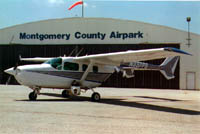ATMS Monitoring — Aerial Observation This program was discontinued in 2014
The aerial traffic surveillance project was a critical part of Montgomery County's transportation management program. The airplane (MC-10) operated during morning and evening peak periods and is available, on demand, at any other time. MC-10 carries a Transportation Management Technician who looks for problems in the system while monitoring several radio frequencies (air traffic reporters, county police, fire & rescue, Maryland State Highway Administration and State Police). On a typical flight MC-10 finds and / or quickly responds to multiple incidents which impact the transportation system. The observer contacts the appropriate authority to respond to the problem, notifies the Transportation Management Center (TMC) to adjust traffic signals in the area of the incident and directly notifies the airborne traffic reporters of the problem. MC-10 is used to perform observations associated with transportation system analysis. The aerial surveillance project was enhanced by the addition of a Wescam gyro-stabilized video / infrared camera mounted to the aircraft. The video from this camera is fed to the TMC, as well as remote sites, by microwave. This video allows decision makers to see the big picture as seen by the observer in MC-10. The observer has a digital camera to take still photos.In addition, MC-10 performs police surveillance, environmental protection activities and assists Fire and Rescue in locating fires in rural areas hard to access.
|
